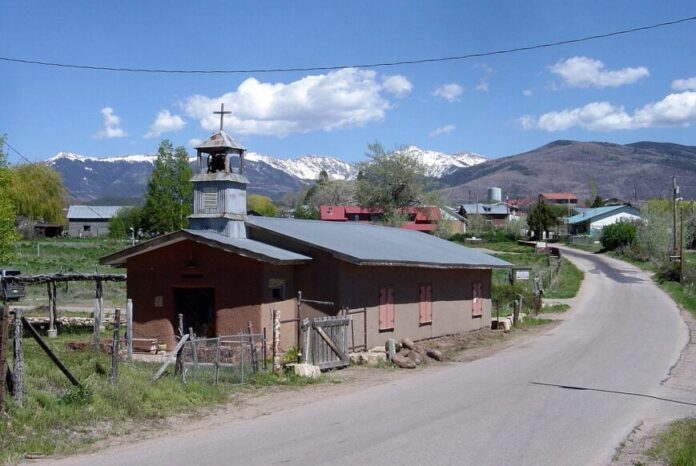Northern New Mexico is a treasure trove of hidden gems, offering some of the most secluded and tranquil towns I’ve ever explored. If you’re like me and crave a peaceful retreat away from the hustle and bustle, these towns provide the perfect escape.
Nestled amidst stunning landscapes, rich cultural heritage, and untouched wilderness, each locale offers a unique blend of serenity and charm. From artists’ havens to high mountain villages, these towns are more than just destinations—they’re experiences that rejuvenate the soul.
Join me as I count down the 25 most secluded towns in Northern New Mexico that you might just fall in love with.
25. Pilar: Riverside Seclusion
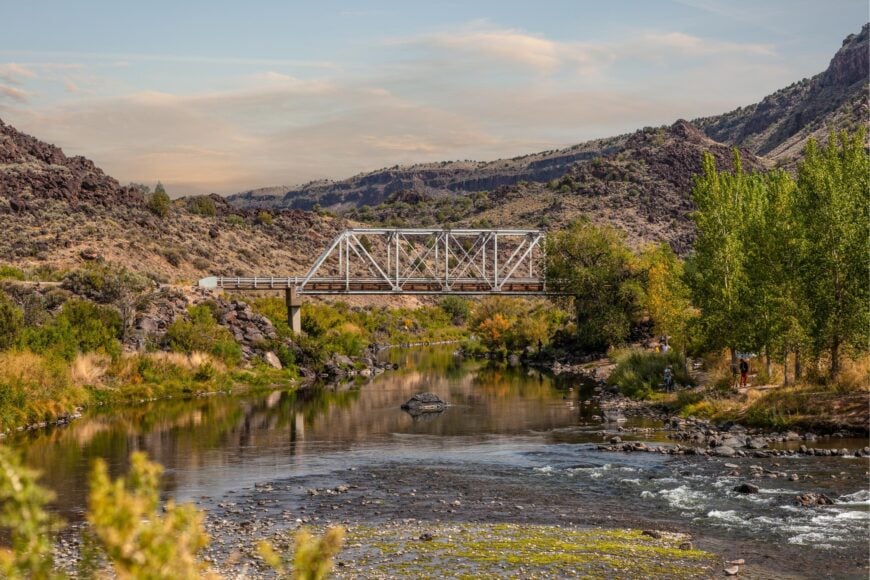
Tucked quietly along the Rio Grande in northern New Mexico, Pilar feels like a bend in the map the world forgot to unfold. Hidden between steep canyon walls and cottonwoods, the town sits just off the river, sheltered by the rugged cliffs of the Rio Grande Gorge and well away from the pace of city life.
There’s no main street buzz—just a scatter of homes, a few artists, and river guides who know the bends by heart. You can fish in the cool, winding waters, hike the Orilla Verde trails, paddle through whitewater, or stumble upon a quiet gallery tucked into a weathered building.
There are no stores, no gas stations—just the soft hush of wind and river and a sky that never ends. Life here hums gently, shaped by those who make do with tourism, art, or simply peace. Pilar doesn’t ask for much, but it offers everything if you’re listening. It’s the kind of place where silence feels sacred, and time seems to slow just for you.
Where is Pilar?
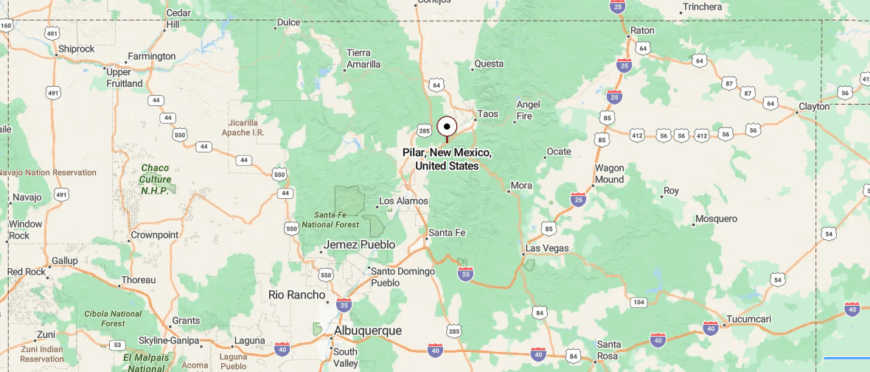
Pilar is nestled in the north-central region of New Mexico, just south of Taos, where the Rio Grande cuts through the rugged canyonlands. It’s about 16 miles southwest of Taos, reachable by taking NM-68 along the river’s edge until the road bends into a more remote stretch of mesa and cliff.
The journey leads through winding, narrow roads flanked by red rock walls and juniper-dotted slopes, with few signs of development once you descend into the river valley. Pilar feels tucked away in time—close enough to Taos for a day trip, but hidden in a canyon so quiet it feels like the world forgets to look.
24. Chama: Mountain Gateway

Cradled in the upper reaches of northern New Mexico, Chama feels like a place time politely passed over. Hemmed in by pine-covered mountains and miles from any freeway sprawl, it sits quietly near the Colorado border, where the air turns crisp and the days stretch out in stillness.
The town moves at the pace of its narrow-gauge steam train—the Cumbres & Toltec Scenic Railroad—chuffing through canyons and over trestles like a moving memory. You can wander through forests along the Continental Divide Trail, fish the Chama River, or warm your hands at a café where ranchers and hikers share the morning.
Tourism helps keep the lights on, with seasonal rail workers, anglers, and snow-seekers drifting through. But even at its busiest, Chama whispers rather than shouts. It’s the kind of place that lets you disappear gently, like steam into pine-scented air.
Where is Chama?
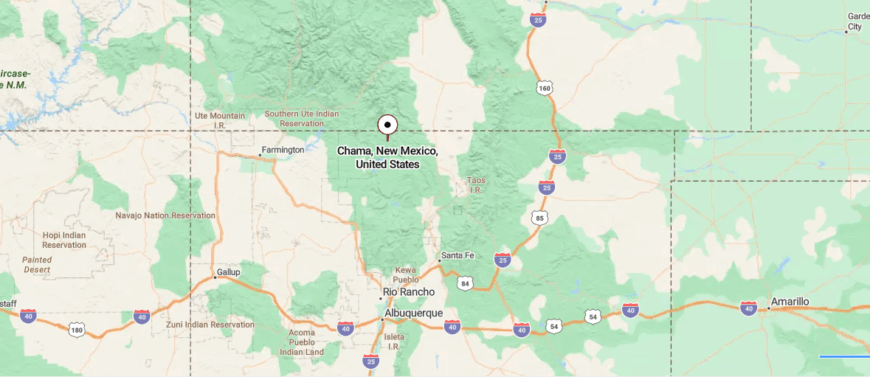
Chama sits in the far north-central corner of New Mexico, near the Colorado border, surrounded by the San Juan Mountains and dense pine forests. It’s about 110 miles north of Santa Fe, reached by driving along US-84 through high desert and mountain passes until the landscape opens into wide alpine valleys.
The road climbs steadily, then drops into this old railroad town where the air turns crisp and quiet. With its remote elevation and backdrop of steam trains and timbered ridges, Chama feels like a forgotten outpost at the edge of the wilderness.
23. Vadito: Hidden Between the Hills

Perched quietly along the High Road to Taos, Vadito is a blink-and-you’ll-miss-it village tucked into the Sangre de Cristo foothills. With only a few dozen homes scattered across piñon-dotted hillsides and no stoplights in sight, it feels worlds away from the nearest city.
Life here unfolds slowly—under wide skies, beside old adobe chapels, and on quiet roads where neighbors wave from porches. You might stop to photograph the historic San Antonio de Padua Church, explore nearby Carson National Forest trails, or drive the High Road itself, a winding route rich with artists’ studios and hidden mountain views.
A few residents work in nearby towns or tend small farms, but many stay for the peace that comes from being just far enough away. Vadito doesn’t offer spectacle, only stillness. It’s the kind of place that settles into your bones without asking for attention—and leaves you a little quieter than it found you.
Where is Vadito?
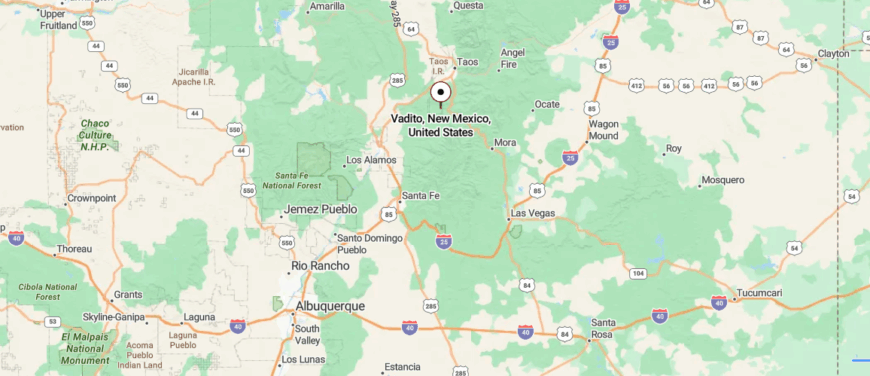
Vadito lies tucked into the northern mountains of New Mexico, along the scenic High Road to Taos between Peñasco and Sipapu. It’s about 45 miles northeast of Santa Fe, accessible via NM-76 as it weaves through small villages, aspen groves, and high desert ridges.
The drive narrows into forested turns and open sky before easing into this quiet hamlet nestled at the foot of the Sangre de Cristo range. Hidden in plain sight along a historic route, Vadito feels like a place time passes through gently, without ever staying long.
22. Youngsville: Solitude by the Cliffs

Tucked between mesas and sagebrush plains, Youngsville rests quietly on the edge of the Santa Fe National Forest, far from noise, traffic, or hurry. With just a handful of homes and an old post office under open sky, it feels more like a pause in the road than a destination—yet its stillness speaks volumes.
The land stretches wide here, with red rock cliffs glowing at dusk and silence broken only by the wind or the cry of a hawk. Visitors can explore the nearby Abiquiú Lake, hike the dramatic Cerro Pedernal made famous by Georgia O’Keeffe, or drive scenic backroads that twist through ghost towns and arroyos.
Some locals tend cattle, others commute to nearby towns, but most are drawn to the space—the kind you can’t measure in miles. There’s no storefront charm or curated welcome, just raw beauty and solitude. It’s the kind of place that doesn’t need to be discovered to matter—where the quiet wraps around you and stays long after you’ve gone.
Where is Youngsville?
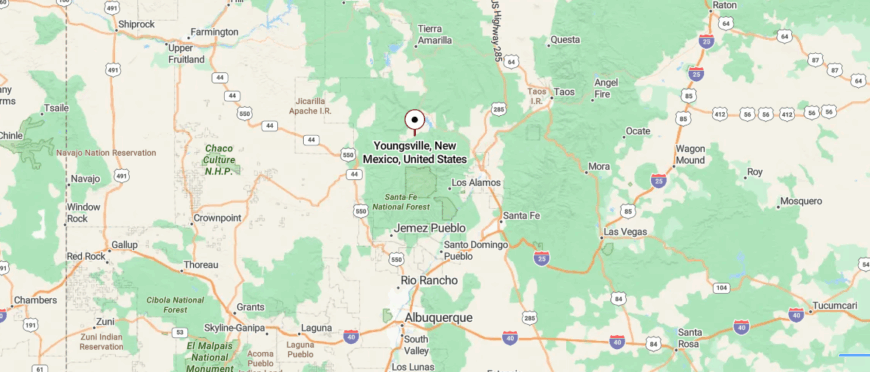
Youngsville rests in the northwest hills of New Mexico, just southeast of Abiquiú and framed by the striking landscapes of the Santa Fe National Forest. It’s roughly 60 miles northwest of Santa Fe, reached by taking US-84 and NM-96 through sandstone bluffs, piñon-studded mesas, and winding desert stretches.
The road grows quieter as it climbs into high country, where cell signals fade and the silence grows deep. Surrounded by open sky and red earth, Youngsville feels like a still breath between worlds—barely a dot on the map, but rich in quiet space.
21. Ojo Caliente: Hot Springs Hideaway

When you turn off the main road and follow the bend toward Ojo Caliente, the world begins to soften. Nestled in a valley of rust-colored cliffs and cottonwoods, this tiny village lives at the rhythm of its ancient springs—quiet, steady, unchanging.
It’s remote but not forgotten, a place where steam rises from mineral pools that have soothed travelers for centuries. You can hike the trails to ancestral pueblo ruins, soak in iron-rich waters beneath the stars, or sit still long enough to hear the wind move through the sage.
The historic spa draws visitors, but the soul of the place lies in its silence and deep, enduring calm. Local life orbits around wellness, small-scale tourism, and the land itself. Ojo Caliente doesn’t just feel off the grid—it feels like it exists in a different kind of time.
Where is Ojo Caliente?
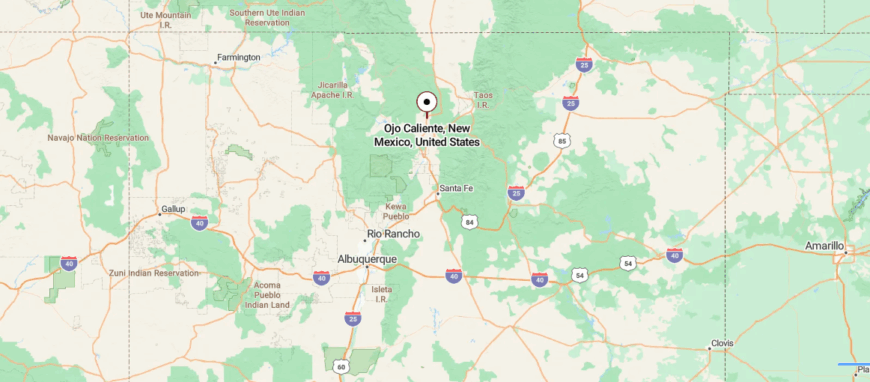
Ojo Caliente is nestled in the northern desert plains of New Mexico, west of the Rio Grande and just beneath the rolling hills of the Carson National Forest. It lies about 50 miles north of Santa Fe, reachable by driving US-285 through open valleys, then turning onto a quieter stretch of road that leads to the mineral-rich springs.
The approach is gentle and sun-soaked, with wide skies and ancient cliffs guiding the way. Even before you arrive, the landscape begins to hush—Ojo Caliente feels like a place made for slowing down and letting the stillness soak in.
20. Cerro: Stillness at the Edge

High in the northern reaches of Taos County, Cerro sits quietly beneath the shadow of its namesake peak, where wide plains meet rugged ridgelines and the wind seems to carry secrets. There are no gas stations, no cafes—just a scattering of adobe homes, old barns, and a road that ends before it begins to matter.
The town feels suspended between sky and soil, distant from noise and untouched by time. You can walk among rustling cottonwoods, trace old acequia paths, or explore the nearby Río Grande del Norte National Monument, where the river cuts deep into ancient stone.
Life here leans on ranching and quiet resilience, with generations staying rooted in this high desert solitude. It’s not a place that calls attention to itself—but it lingers in memory. Cerro is the kind of place that doesn’t ask for anything, yet somehow gives you space to breathe in a way the rest of the world forgets.
Where is Cerro?
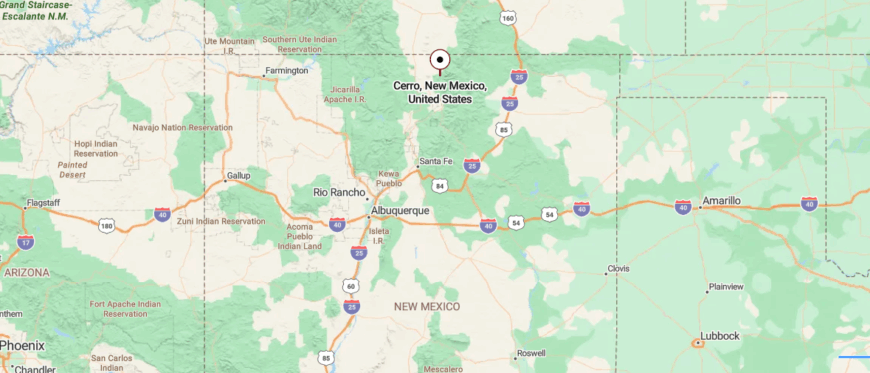
Cerro is tucked into the northernmost reaches of New Mexico, near the Colorado border and just east of the Rio Grande del Norte National Monument. It’s about 25 miles northwest of Taos, accessible via NM-522 as it stretches through windswept plains, volcanic plateaus, and distant views of the Sangre de Cristo Mountains.
The road narrows near the village, where old adobe homes rest quietly under big skies and open land rolls on for miles. Cerro feels like the edge of something vast—a place where silence settles easily and the horizon never rushes in.
19. Talpa: Tucked Below Taos

Folded into the gentle hills just south of Taos, Talpa feels like a village hidden in plain sight—sheltered by cottonwoods, steeped in quiet, and threaded with the scent of piñon smoke. Though close to the bustle of Taos, it feels far removed, tucked off the main road and cradled by old acequias and winding dirt lanes.
The rhythm here is slow, marked by family gardens, adobe chapels, and the sound of roosters greeting the day. You can walk the narrow trails to the Talpa Ridge, visit the historic San Juan de Los Lagos chapel, or simply sit under the trees where elders still gather to talk.
Most residents have roots generations deep, tending land or working in nearby Taos while keeping Talpa’s traditions intact. It’s a place where the past hums just beneath the present. And it’s the kind of place that stays with you—not because it tries to, but because its stillness feels like home.
Where is Talpa?
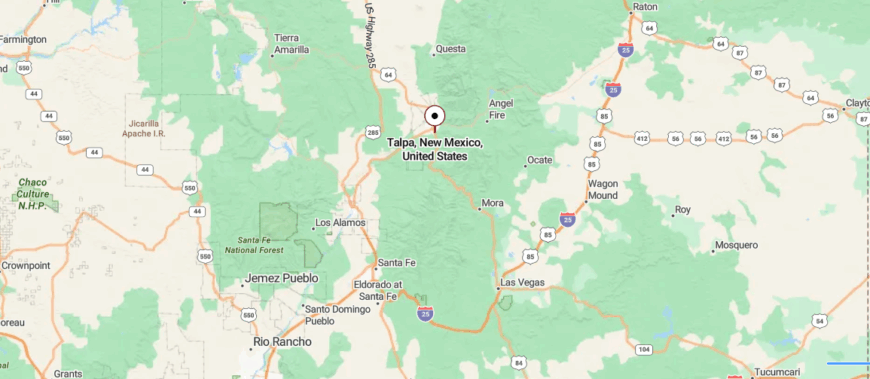
Talpa lies just south of Taos in north-central New Mexico, nestled in the foothills where the mountains begin to fold into the high desert. It’s only about 6 miles from the Taos Plaza, reached by meandering down NM-518 past cottonwoods, old chapels, and quiet rural byways.
The route winds gently through the valley, with glimpses of farmland and adobe homes tucked behind low stone walls. Though close to the hum of Taos, Talpa feels tucked away—a peaceful bend in the road where life moves slowly and the landscape speaks in whispers.
18. Amalia: Life on the Edge

Up near the Colorado border, where the mountains start to rise and the sky stretches without end, Amalia lies quietly—almost unnoticed—at the edge of everything. Surrounded by forests, mesas, and miles of open land, it’s a place where roads narrow, cell signals fade, and the loudness of the world slips away.
The village is small and scattered, with weathered homes, family plots, and old fences tracing stories through the sagebrush. You can hike into the Carson National Forest, fish the Río Costilla, or explore the hidden trails near Valle Vidal where elk outnumber people.
Ranching and quiet self-reliance define much of daily life here, with generations tending the same land under the same sky. Amalia doesn’t try to charm—it simply exists in its own quiet way. It’s the kind of place where silence feels deep enough to hold your thoughts, and the wind sounds like it’s been there longer than memory.
Where is Amalia?
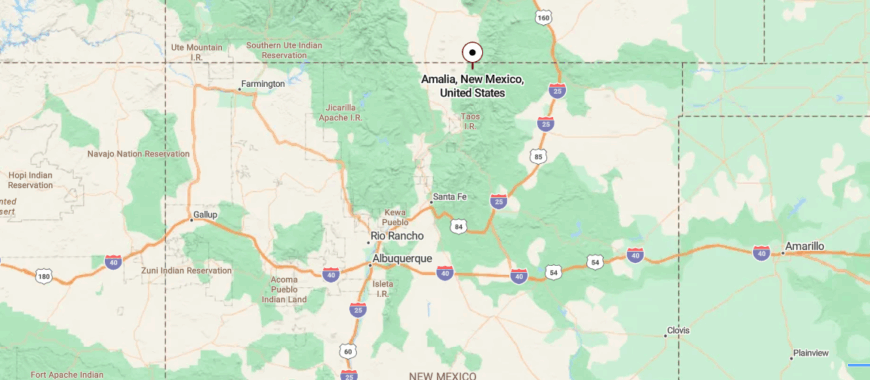
Amalia sits hidden in the far northern corner of New Mexico, near the Colorado state line and nestled between the Sangre de Cristo Mountains and the Rio Costilla. It’s about 40 miles north of Taos, reached by following NM-522 and turning onto a winding rural road that climbs through forested valleys and open meadows.
The journey grows quieter with every mile, passing few signs of modern life as the road edges into alpine solitude. Surrounded by peaks and sky, Amalia feels like a town paused between seasons—remote, hushed, and deeply rooted in the land.
17. El Prado: The Quiet Side of Taos

Just north of Taos, where the high desert meets shifting light and the mountains keep watch, El Prado stretches out wide and unbothered. It’s not a town in the traditional sense—more a patchwork of artist studios, adobe homes, and open space woven together by sky, silence, and creativity.
Though only minutes from Taos Plaza, El Prado feels a world apart, with dirt roads, distant horizons, and sunsets that paint the mesa in fire and rose. You might browse local galleries tucked into old gas stations, drive the Enchanted Circle Scenic Byway, or wander past fields where horses graze beneath the Sangre de Cristo peaks.
Many who live here do so for the art, the solitude, or both—finding quiet inspiration in the vastness. There’s no downtown, no distractions, just a slow unfolding of land and light. It’s the kind of place that reminds you that space itself can be a kind of beauty—and a kind of freedom.
Where is El Prado?
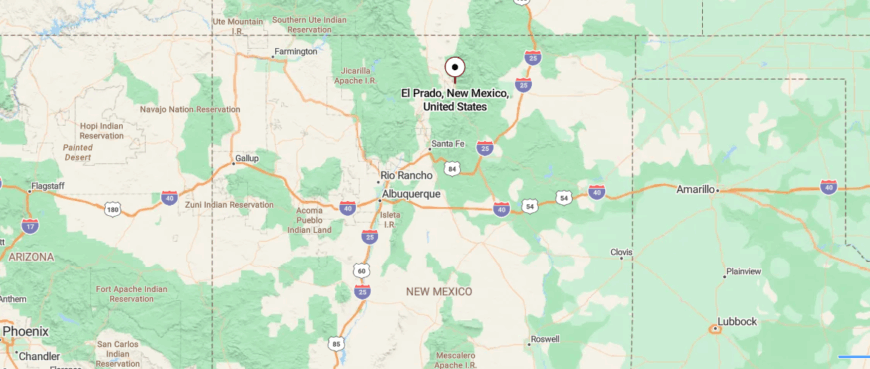
El Prado lies just north of Taos in the high desert plain of north-central New Mexico, where the wide-open mesa meets the distant rise of the Sangre de Cristo Mountains. It’s only about 4 miles from Taos Plaza, easily reached via US-64 as it stretches past adobe galleries, quiet homesteads, and the sprawling sky above the Río Grande Gorge.
The drive is brief but expansive, with each turn offering more space, more silence, more horizon. Though close to town, El Prado feels like the beginning of elsewhere—where the land opens up and the pace gently drifts away.
16. Arroyo Hondo: Hills and Heritage

Nestled in a fold of hills where the land dips gently toward the Río Hondo, Arroyo Hondo lives in the hush between mountain and mesa. Just a short drive from Taos, it somehow escapes the rush, holding onto its quiet with adobe arms and cottonwood shade.
The village hums with history—once a trading stop, now a scattering of old homes, orchards, and winding backroads that seem to lead inward as much as out. You can walk near the old John Dunn Bridge, soak in hidden hot springs, or follow the river’s path through canyons carved by time.
Locals are a mix of artists, ranchers, and those drawn to the stillness that clings to the arroyo’s curve. Life here doesn’t hurry; it listens. Arroyo Hondo is the kind of place that feels like a deep breath—one you didn’t realize you were holding until you finally let go.
Where is Arroyo Hondo?
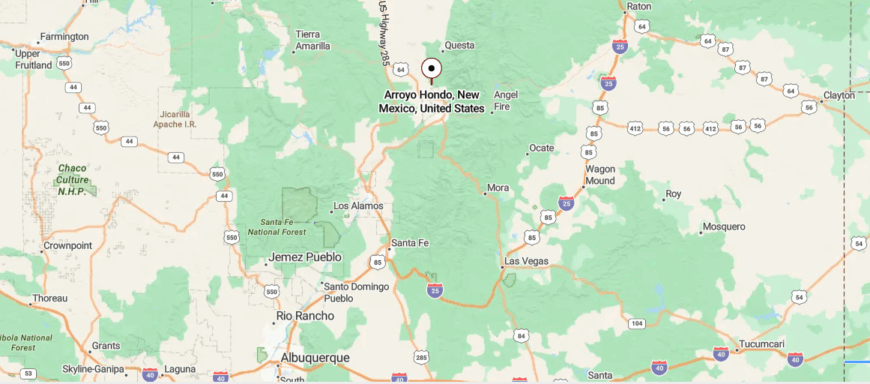
Arroyo Hondo rests in the northern highlands of New Mexico, nestled in a deep fold of the land just 8 miles north of Taos. It’s reached via NM-522, where the road curves gently past sagebrush plains and into a lush river valley framed by cottonwoods and steep canyon walls.
The descent into the arroyo feels like slipping into a hidden passage, quiet and cool even in summer heat. With its sheltered fields and murmuring stream, Arroyo Hondo feels like a pocket of calm carved quietly into the landscape.
15. La Villita: Whisper of the Valley

Tucked quietly along the banks of the Río Grande, La Villita is the kind of village you might pass without knowing, yet it holds the rhythm of centuries in its soil. With only a handful of homes, old acequias winding through fields, and views framed by distant hills, it feels suspended between past and present.
There are no shops, no signs of rush—just the hum of bees in orchard trees, the rustle of cottonwoods, and the soft patter of footsteps on dirt paths. You can walk the river’s edge, visit nearby Española for supplies, or sit beneath the sun-drenched sky where elders have watched seasons shift for generations.
Most who live here do so quietly, tending land passed down through time or commuting to nearby towns, all while rooted deeply in place. There is no performance here—only presence. La Villita is the kind of place where life speaks softly, and you finally learn how to listen.
Where is La Villita?
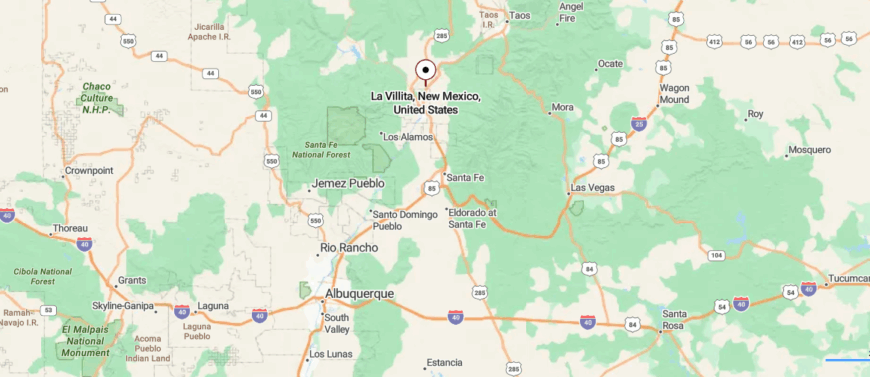
La Villita is tucked into the northern Rio Grande Valley of New Mexico, just east of the river and surrounded by fields and cottonwoods near Española. It’s located about 30 miles north of Santa Fe, reached by following US-285 and then turning onto quiet county roads that weave through farmland and old adobe homesteads.
The drive slows as the highway gives way to narrow lanes bordered by orchards, pastures, and the occasional roadside shrine. La Villita feels quietly rooted—close to larger towns, yet held apart by its gentle rhythm and deep connection to the land.
14. El Guique: Lost in the Lowlands
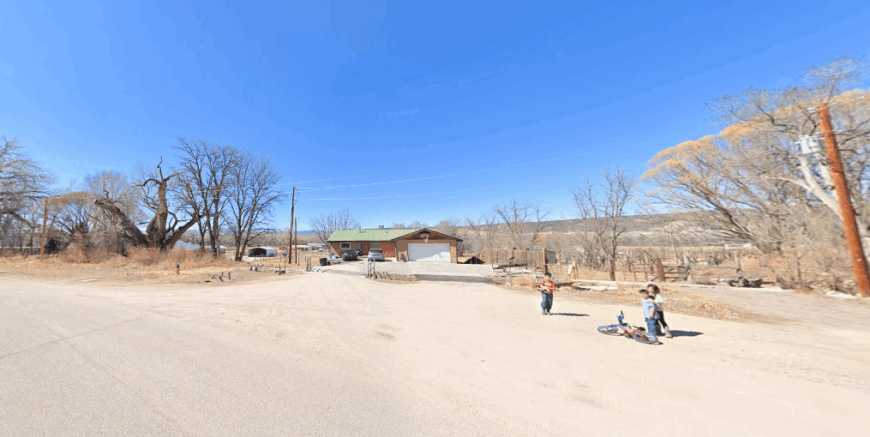
Set between river and mesa in the heart of northern New Mexico, El Guique is a small village that seems to exist just outside the passage of time. Hidden along a quiet stretch of the Río Grande, it’s easy to miss—there are no crowds, no bright signs—just fields, adobe homes, and the deep hush of land that remembers its past.
The scent of juniper drifts through the air, and the sound of irrigation water trickling through ancient acequias blends with birdsong and wind. You might take a slow drive along Highway 68, stop to photograph the layered cliffs nearby, or follow backroads that lead to forgotten orchards and sunbaked chapels.
Farming still anchors life here, alongside a deep sense of heritage passed through generations. The village doesn’t draw attention, but it doesn’t need to. El Guique is the kind of place where stillness feels sacred—and the land itself seems to speak.
Where is El Guique?
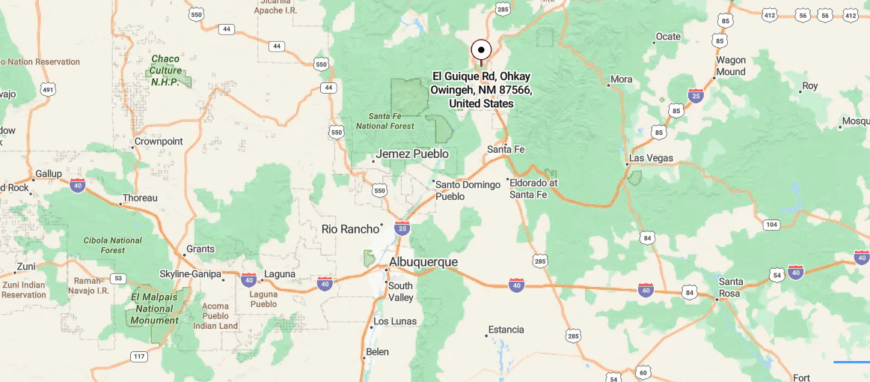
El Guique lies in the north-central Rio Grande corridor of New Mexico, between Española and Ohkay Owingeh, nestled close to the river’s edge and backed by low mesas. It’s about 35 miles north of Santa Fe, reached via US-84/285 and a short turnoff onto a narrow rural road that dips into quiet farmland.
The route passes sunbaked fields and scattered homes, with the hum of the highway quickly fading into stillness. El Guique feels quietly suspended between past and present—a small riverside village where the world seems to slow and soften.
13. Cordova: Crafts and Quietude

Tucked into the folds of the Sangre de Cristo Mountains along the High Road to Taos, Cordova feels like a village etched gently into the land—quiet, rooted, and brimming with history. Shielded by forested slopes and far from any rush of modern life.
The scent of pine mingles with woodsmoke, and the silence is broken only by the creak of a gate or the rhythm of tools in a workshop. You can explore local carvings that echo centuries-old traditions, visit the historic church of San Antonio, or hike the trails that disappear into Carson National Forest.
Many residents carry on family trades, especially santero wood carving, blending art, faith, and place in every piece. Cordova doesn’t announce itself—it simply endures. It’s the kind of place where time feels carved slow and deep, and the mountains hold your thoughts a little longer.
Where is Cordova?
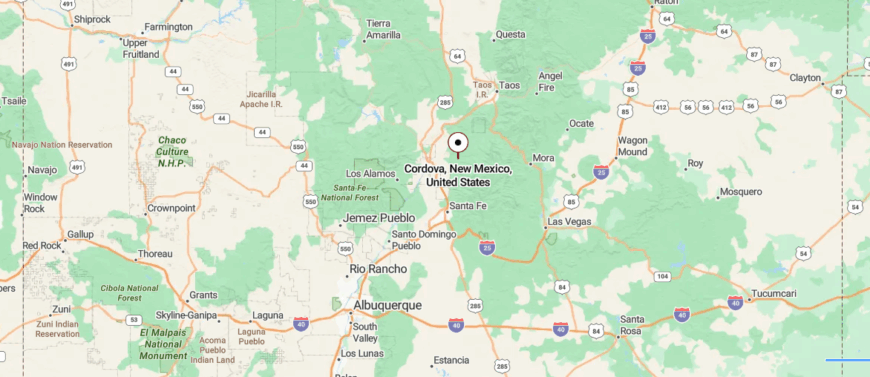
Cordova is tucked high in the foothills of the Sangre de Cristo Mountains in north-central New Mexico, hidden along the scenic High Road to Taos. It’s about 45 miles northeast of Santa Fe, reached by winding through NM-76 past the village of Chimayó and climbing into the pine-dotted hills.
The journey narrows into a quiet stretch of road, where adobe homes appear suddenly against a backdrop of forest and sky. Sheltered by elevation and time, Cordova feels like a hidden crest in the hills—where each turn carries you deeper into stillness.
12. Cundiyo: Hidden Near the Monastery

Hidden deep in the hills between Chimayó and Truchas, Cundiyo is one of those villages you reach only if you’re meant to find it. Surrounded by wooded ridges, narrow valleys, and old acequias that still flow clear, it rests far from highways and even farther from hurry.
The air is rich with the scent of piñon and earth, and the quiet feels older than the road itself. You can walk past the historic adobe church, listen to the Río Medio wind through the trees, or explore trails that lead into the forested canyons of the Sangre de Cristos. Life here is deeply tied to the land—farming, faith, and tradition passed down in quiet constancy.
There are no shops, no crowds, just the rhythm of days shaped by nature and memory. Cundiyo is the kind of place that holds its silence like a prayer—and invites you to do the same.
Where is Cundiyo?
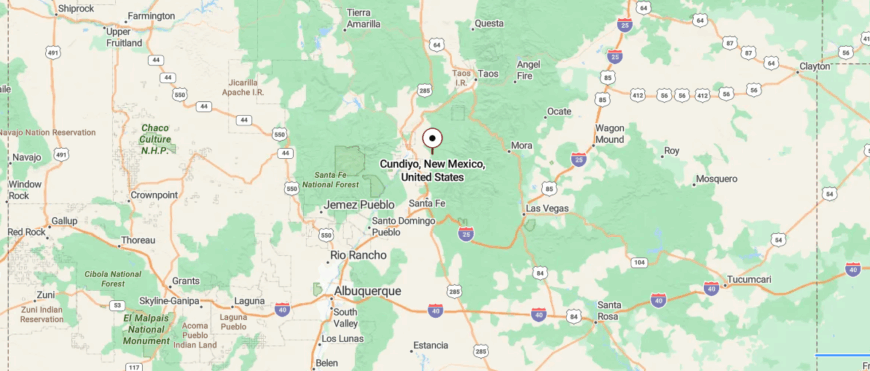
Cundiyo is nestled in a narrow valley of the Sangre de Cristo foothills in north-central New Mexico, just east of the village of Chimayó. It’s about 30 miles northeast of Santa Fe, reached by winding along NM-503 and turning onto a small road that descends into the cottonwood-lined banks of the Rio Medio.
The drive dips through hills and curves into a quiet basin, where scattered adobe homes rest near the water and time seems to linger. With its sheltered location and hidden approach, Cundiyo feels like a quiet breath between mountains—secluded, rooted, and softly held by the land.
11. Los Ojos: Quiet Between the Lakes

Tucked into the northern highlands near Chama, Los Ojos sits quietly beneath a canopy of ponderosa pines and open skies, where the land rises and falls in gentle rhythm. Surrounded by forest, ranchland, and the winding Río Brazos, the village feels both sheltered and expansive—remote enough to be forgotten by time, yet rich with enduring life.
Wooden fences line the fields, and old log barns speak to generations of sheep herders and weavers who still work with their hands. You can visit the Tierra Wools weaving cooperative, fish in the nearby Brazos River, or hike toward the jagged cliffs that rise like a stone curtain to the east.
The economy leans on fiber arts, ranching, and a slow trickle of tourism—mostly those seeking the kind of peace you can’t schedule. There’s a stillness here that hums beneath every footstep, grounded and unspoken. Los Ojos is the kind of place where the land remembers everything—and reminds you to slow down long enough to listen.
Where is Los Ojos?
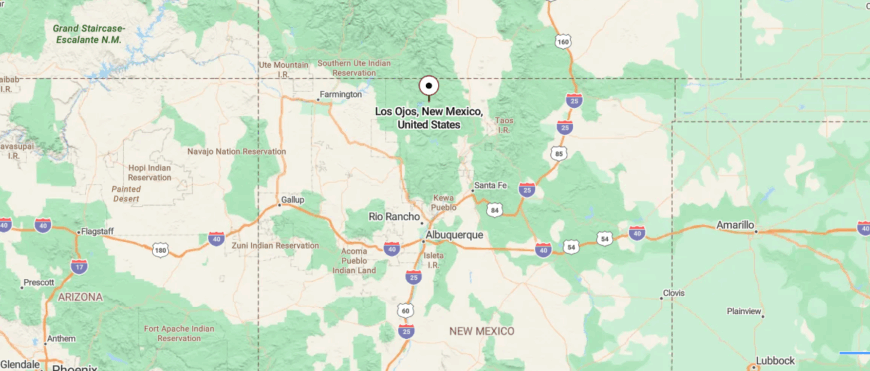
Los Ojos is tucked into the northern mountains of New Mexico, just south of Chama and east of El Vado Lake, where forested hills roll into ranchland meadows. It’s about 100 miles northwest of Santa Fe, reached by taking US-84 through high desert and pine-covered slopes until the road dips into the quiet heart of the valley.
The approach winds past old homesteads and grazing fields, with the distant hum of the highway giving way to stillness and crisp mountain air. Surrounded by quiet ridges and open skies, Los Ojos feels like a peaceful clearing at the edge of the wilderness—steady, timeless, and far from the rush.
10. Llano Quemado: Hidden Gem of the North

With a population of just over 700, Llano Quemado offers a peaceful environment that’s hard to find elsewhere. I love strolling through its quiet streets, where the traditional adobe homes reflect the rich Pueblo influence.
Outdoor enthusiasts can explore the nearby Rio Grande Gorge or enjoy bird watching in the serene surroundings. Agriculture is a significant part of life here, with local farms dotting the landscape.
What makes Llano Quemado truly secluded is its location away from major highways and urban centers, providing a tranquil lifestyle amidst natural beauty.
Where is Llano Quemado?

Llano Quemado is located just south of Taos in Northern New Mexico. Its seclusion comes from being nestled in the valleys, surrounded by rolling hills and sparse development.
To get there, I usually take State Road 68 from Taos, which is a scenic drive offering breathtaking views of the high desert terrain. The town’s remote location ensures a quiet atmosphere, making it a hidden gem that’s perfect for those seeking solitude.
9. Sapello: Seclusion in the Meadows

Sapello, home to a small community of around 500 residents, is nestled amidst open meadows and lush greenery. I find peace in its vast landscapes, where cattle graze and time seems to slow down.
Outdoor activities like hiking and fishing in the nearby Sapello River are popular among locals. The area is primarily agricultural, with ranching being the main industry.
Sapello’s low population density and absence of commercial development make it an ideal spot for those looking to escape the noise of city life.
Where is Sapello?

Located in San Miguel County, Sapello is about 20 miles north of Las Vegas, New Mexico. Its seclusion is enhanced by its rural setting, surrounded by open fields and distant mountains.
I usually access Sapello via State Highway 518, a route that offers a scenic drive through forests and meadows. The town’s remote location and limited infrastructure contribute to its quiet, undisturbed atmosphere.
8. Dixon: An Oasis of Peace

Dixon, with a population of around 800, offers a rural ambiance that’s both inviting and serene. I enjoy visiting the local wineries and art galleries that showcase the town’s creative spirit. The Embudo River provides opportunities for fishing and leisurely walks along its banks.
Dixon’s main industries include agriculture and art, with many residents engaged in farming and crafts. Its remote location, away from the hustle of larger towns, offers a quiet lifestyle that’s perfect for relaxation.
Where is Dixon?

Nestled along the Rio Embudo, Dixon is located between Taos and Española on State Road 75. The town’s seclusion is due to its valley setting, surrounded by hills that shield it from major roadways.
I access Dixon via a scenic route that winds through the mountains, adding to the sense of escape. The lack of commercial development and its tucked-away location make Dixon a peaceful retreat away from city bustle.
7. La Madera: Quiet Life in the Mountains

La Madera is a small village with a population of about 150, offering a serene mountain setting that I find incredibly rejuvenating. The expansive lot sizes and natural surroundings provide ample privacy for residents.
Outdoor activities include hiking in the Carson National Forest and exploring nearby hot springs. The main industry here is small-scale agriculture and some arts and crafts. La Madera’s seclusion comes from its remote location and the untouched wilderness that envelops it.
Where is La Madera?

Located in Rio Arriba County, La Madera sits along State Road 111, northwest of Española. Its mountainous terrain and distance from major highways enhance its secluded feel.
I reach La Madera by taking a scenic drive through the forested areas, which adds to the sense of isolation. The village’s location amidst natural surroundings makes it a perfect spot for those seeking a quiet life in the mountains.
6. Cañones: Seclusion Amidst Canyons

Cañones is a tiny community with fewer than 100 residents, offering isolation like no other. I appreciate the town’s unique setting amidst rugged canyons and mesas. The area is perfect for hiking, photography, and exploring geological formations.
There are no significant industries, which maintains its untouched charm. Cañones’ limited population and distance from urbanization make it an ideal place for a peaceful retreat.
Where is Cañones?

Cañones is located in the northern part of Rio Arriba County, accessible via Forest Road 100. Its seclusion is due to the natural barriers of canyons and lack of nearby towns.
I find that getting there involves navigating winding roads through the Santa Fe National Forest, which adds to its remote allure. The town’s hidden position amidst the canyons ensures a tranquil environment away from the crowds.
5. El Rito: A Peaceful Retreat

El Rito, home to approximately 1,000 residents, is a place where time seems to stand still. I enjoy visiting the historic El Rito Presbyterian Church and exploring the local art scene. The town’s spacious landscapes and low housing density provide a quiet rural atmosphere.
Main industries include education, with a campus of Northern New Mexico College, and some local crafts. El Rito’s remote location and minimal commercial development make it a peaceful retreat.
Where is El Rito?

El Rito is situated in Rio Arriba County along State Road 554. Its seclusion is due to its position away from major highways and surrounded by the Carson National Forest.
I usually reach El Rito by driving through scenic mountain roads that emphasize its isolation. The town’s quiet charm and natural surroundings make it a haven for those looking to escape the hustle and bustle.
4. Vallecitos: Hidden in the Valleys

Vallecitos is a small village with around 500 residents, nestled in a valley that offers seclusion and natural beauty. I find peace in its quiet streets and the simplicity of rural life. Outdoor activities include fishing in the Vallecitos River and hiking in the nearby forests.
The main industries are agriculture and some local crafts. The town’s natural barriers and minimal development make it perfect for a peaceful retreat.
Where is Vallecitos?

Located in Taos County, Vallecitos is accessible via State Road 576. Its seclusion is enhanced by the surrounding mountains and forests that isolate it from larger towns.
I get there by driving through winding roads that offer stunning views, reinforcing the sense of being hidden away. The town’s location in the valleys contributes to its undisturbed and tranquil atmosphere.
3. Tres Piedras: Where the Pines Meet the Sky

Tres Piedras, with a population of about 900, is surrounded by dense forests of pines and aspens. I enjoy the area’s outdoor activities like hiking, mountain biking, and exploring the Tusas Mountains.
The main industries include forestry and some tourism related to the natural attractions. Its isolation comes from being distant from major highways and urban centers, making it ideal for those seeking privacy.
Where is Tres Piedras?

Located along US Highway 64, west of Taos, Tres Piedras sits at the junction of expansive forests and high desert plains. The town’s seclusion is due to its vast natural surroundings and low population density.
I find the drive there, through mountainous terrain, adds to its remote feel. Tres Piedras’ position amidst forests and away from bustling cities makes it a serene destination.
2. Truchas: High Mountain Serenity

Truchas, home to about 600 people, is perched high in the mountains, offering breathtaking views and serenity. I am always inspired by its vibrant art community and the historic Spanish architecture.
Outdoor activities include hiking the Truchas Peaks and exploring the High Road to Taos. The main industries are arts and crafts, with many local galleries. Its high-altitude location and sparse population provide an untouched wilderness away from urban centers.
Where is Truchas?

Situated on the High Road between Santa Fe and Taos, Truchas is accessible via State Road 76. Its seclusion comes from being nestled at 8,000 feet elevation, surrounded by the Sangre de Cristo Mountains.
I reach it through winding mountain roads that offer stunning vistas. The town’s remote setting and elevation contribute to its peaceful and secluded atmosphere.
1. Abiquiú: The Artists’ Secluded Haven

Abiquiú, with a population of just over 200, is famed for its tranquil and remote setting that has long inspired artists like Georgia O’Keeffe. I love visiting the Abiquiú Lake for kayaking and the Ghost Ranch for its stunning landscapes.
The main industries are tourism and art, with galleries and tours celebrating the area’s creative heritage. Its low population density and expansive natural landscapes offer solitude and inspiration unlike any other place I’ve been.
Where is Abiquiú?

Abiquiú is located along US Highway 84 in Rio Arriba County. Its seclusion is due to the vast surrounding desert mesas and rock formations that isolate it from larger towns. I usually drive through scenic routes that showcase the area’s unique geology.
The town is about an hour’s drive from Santa Fe, making it accessible yet peacefully removed from urban life. Abiquiú’s natural beauty and quiet atmosphere make it the perfect artists’ haven.
